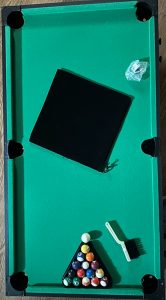As a team, the majority of our time these past two weeks was focused on the design report and beginning to implement our project. We spent significant time on the design report to make sure that we could best convey our idea of our project to the reader. Additionally, we went more in-depth into how our system works and how each part comes together: creating a comprehensive block diagram, function signatures for software subsystems, choosing and ordering the exact hardware parts we will be using, and more. The more in-depth research/development of our project has made it easier for us to actually begin and go through with implementation, as we will have a majority of it detailed in our design report.
As for implementation, we have started implementing the major software subsystems of our project — the CV and the Physics Simulation. The third software subsystem, the display mapping, will be completed after the physics simulation is finished. Unfortunately, we are in a bit of a roadblock in terms of our physical implementation. We’ve received the projector and camera that we will be using for our project, however, we have yet to receive the physical pool table we will be working on. When we asked the ECE mailing room if they had received the pool table package yet from Amazon, they said it was still delayed. We will be checking again tomorrow after we meet with Professor Brumley, and are hoping the pool table will be in ASAP.
Overall, we are making steady progress on our project despite being blocked. There are no changes to the schedule on the software side of our project, however, we will need to speed up the schedule for our physical side of the project due to not being able to work on it just yet.




